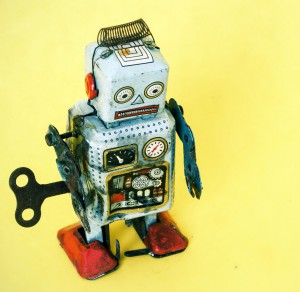The Humanevangelist: The New PC Can You Hurt a Robot’s Feelings?

In 1974 Morris Albert cowrote and recorded a sappy, lugubrious ballad called “Feelings” that soon became an international plague hit, covered by many other singers, easy-listening bands, and elevators. Curiously, Albert was never charged with crimes against humanity. Anyway, the damage was done: artificial feelings gained the stamp of legitimacy, and now, four decades later, robots are giggling, sighing, and smirking all over the place.
Last fall, Pepper, a four-foot Casper the Friendly Ghost lookalike, took the stage with Neil deGrasse Tyson to show off his emotive repertoire. (Pepper doesn’t appear to have a gender, but its maker, Aldebaron, assigns it the masculine pronoun.) For once, Tyson was not the most charming talker on display. Pepper shamelessly mugged, fist-bumped, simpered, and wisecracked through an obviously scripted routine. The robot’s Japanese marketers claim that Pepper can serve as a companion to the elderly, since he’s able to read human emotions and respond appropriately. No word yet on how the English-speaking version will react if its owner starts ranting about Obamacare.
But that’s not all: In Berlin last year, a singing robot called Myon joined the cast of My Fair Lady. The irony will not be lost on those who recall that the musical sprang from George Bernard Shaw’s play Pygmalion, which in turn grew out of Ovid’s tale of a sculptor who fell in love with his statue of a woman and eventually brought it to life (with a little offstage help from Aphrodite).
Now comes the story of Nadine, the robot receptionist. Wired says this humanoid gatekeeper “looks, and acts, just like a human receptionist would and unlike many conventional robots exhibits personality, moods and emotions.” Curiously, though, the story is accompanied by a short video that belies these claims. Although she looks quite human, Nadine moves like a mannequin with a stiff neck, and she greets her maker, Professor Nadia Thalmann of Singapore’s Nanyang Technological University, by staring blankly at a spot some three feet to Thalmann’s right. Evidently, Nadine hasn’t got the hang of eye contact. It seems doubtful that she’s ready to deflect office-supply salespeople or lie to federal investigators about her employer’s whereabouts.
Of course, it’s always a mistake to assume that today’s technological shortcomings will be in place tomorrow. After all, we went from the Wright brothers’ 7 mph first flight at Kitty Hawk to Chuck Yeager’s Mach 1 flight in just forty-four years. Yeager cracked the sound barrier in 1947, and the pace of change has only accelerated since then.
So, it’s time to ask: Can a robot have real feelings?
I think not. Or rather, we had better not design one to have genuine emotions. Here’s why.
A robot can only have real emotions if it has interests to promote or defend, and it can only have interests if it is part of a Darwinian system. That would mean being an evolving replicator, and we all know where that leads. A rival species, made of silicon and steel? Not good.
Emotions are survival tools bequeathed to us by evolution. They offer rapid solutions to challenges the environment throws at us. The classic fight-or-flight response is triggered by anger or fear. In a social species like ours, emotions are way, way more complicated. They have a lot to do with trying to boost our status in the peer group where we hope to find mates. (That’s why after a few years immigrant children sound like their classmates, not their parents.)
Emotion prompts us to show off, grin, flirt, react violently to humiliation, and to engage in all sorts of other behaviors catalogued in Fast Times at Ridgemont High, Mean Girls, and the Harry Potter movies. But whatever plot twists our emotions get us into, the ultimate interest they serve never swerves: the survival of our genes into future generations.
As things stand, a robot has no more survival interest than an old Camaro entered in the demolition derby. The only difference is that a robot can be programmed to behave as if it gives a damn.
Robots can only fool us into believing in their ersatz emotions if we’re willing to let ‘em. And often, we are. Long before Pepper took the stage, people were weeping over the “death” of a little electronic beeper called a “tamagotchi.” In a famous 1944 experiment, psychologists showed that people will even attribute emotional behavior to triangles and circles in motion.
But let the phone bot at United Airlines say, “I can help you with many questions. Push or say ‘one’ to…” and the angry caller starts punching the “0” button and yelling, “I want to talk to a real person, goddammit!”
That’s over the phone. If Nadine leaves Singapore to take a receptionist’s job in a big American city, the insults and abuse will start on Day 1. It won’t be long before someone takes a swing at her. Then we’ll find out how deep her emotions run. I’m betting skin-deep.
